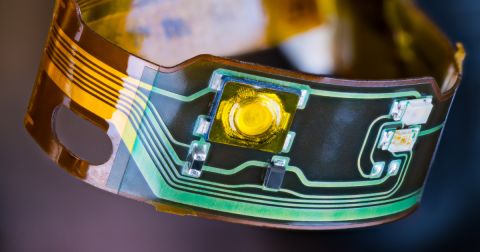Biodegradable Electronics: Engineering the Future of Transient Devices

The electronics industry faces a daunting challenge: according to the UN's Global E-waste Monitor 2024, electronic waste reached 62 million tonnes in 2022, up 82% since 2010, with only 22.3% being formally recycled. E-waste is rising five times faster than documented recycling rates, growing by approximately 2.3 million tonnes annually, and is projected to reach 82 million tonnes by 2030. This crisis has catalyzed a fundamental shift in how we approach electronic design, pushing engineers toward a new paradigm: transient electronics that disappear when their job is done.
Emerging technologies are paving the way for entirely new applications that were previously impossible with conventional electronics. Imagine environmental sensors that monitor soil conditions during a growing season, then harmlessly decompose into the earth. Or medical implants that deliver targeted therapy, monitor healing and then dissolve without requiring surgical removal.
Beyond these immediate applications, biodegradable electronics open possibilities for temporary installations, deployable systems, and environmentally conscious consumer devices. This emerging field combines innovative materials science, precise manufacturing controls, and creative engineering solutions to create devices that perform their intended functions and then disappear without a trace.
The Materials Behind the Science
The foundation of biodegradable electronics rests on innovative materials science developments, with recent advances improving thermal stability and conductivity. In addition, breakthroughs in composite materials show promise for enhanced performance while maintaining biodegradability.
Research demonstrates the successful implementation of cellulose-based substrates supporting complex circuits while maintaining biodegradability. These substrates achieve thermal stability of 165°C ±5°C (IEEE TCPMT 2023), making them compatible with modified surface-mount assembly processes. The substrate development process involves careful consideration of multiple factors, including mechanical stability, thermal characteristics, and degradation timing. Researchers have successfully incorporated natural flame retardants derived from clay minerals, addressing crucial safety requirements for commercial applications.
Conductive elements research shows significant progress with magnesium-based conductors achieving viable conductivity levels while maintaining biodegradability in physiological conditions. These conductors can be tuned through alloying to control dissolution rates without significantly compromising electrical performance.
Recent innovations in PEDOT (Poly(3,4-ethylenedioxythiophene)) derivatives demonstrate significant progress in biodegradable electronics. These conductive polymers, which can be processed at lower temperatures than metals and offer mechanical flexibility, can achieve conductivity values that sometimes exceed traditional PEDOT:PSS through careful composition and treatment. With controllable degradation rates and biocompatibility, these materials provide valuable solutions for biomedical applications requiring both electrical performance and programmed dissolution.
Rethinking Circuit Architecture
Engineers working with biodegradable components must reconsider traditional design rules. Due to thermal and mechanical properties, circuit spacing increases by 15 to 20% compared to conventional PCBs. The design process must account for progressive material degradation, it is worth simulating circuit behavior throughout the degradation timeline, such as with SPICE.
Power distribution is also a challenge as higher power brings more thermal load, and this could increase the degradation rate of a biodegradable material. In the case of using biodegradable conductors, this might require wider traces or a heat sinking strategy. As initial conductive paths degrade, there may be a need for redundant circuitry to maintain functionality, which has been demonstrated in research and testing.
Manufacturing Processes and Quality Control
Manufacturing equipment and processes are evolving to meet the unique demands of biodegradable materials. Modified assembly systems now achieve pick-and-place accuracy matching traditional component placement within 25 microns. Key innovations include reduced residence time in extruders, advanced moisture control systems and gentler mixing mechanisms to prevent polymer degradation. These adaptations address the fundamental sensitivity of biodegradable polymers to heat and shear, aligning with broader industry trends toward sustainable processing.
Temperature control remains critical throughout the manufacturing process. Research confirms most biodegradable substrates maintain stability at 165°C ±5°C, necessitating specialized reflow profiles and modified cleaning processes. Plasma treatment systems improve adhesion while maintaining material integrity. Researchers have reported production yields of 85-95% for biodegradable components, though costs have been running 35 to 45% higher than traditional electronics – a premium expected to decrease as processes mature.
Quality control uses advanced non-destructive testing methods, including X-ray inspection techniques that verify internal structures while preserving material integrity. Environmental chambers test performance by simulating various deployment conditions throughout intended product lifetimes. Such comprehensive testing ensures reliability while carefully balancing functionality with controlled decomposition.
Healthcare Monitoring and Drug Delivery
Medical researchers have demonstrated the successful implementation of dissolving sensors for post-operative monitoring in cardiac procedures. These devices provide monitoring data during healing periods before they safely dissolve. The elimination of removal surgery reduces patient risk and medical costs while delivering equivalent monitoring capability.
Advanced drug delivery systems represent another breakthrough application. Biodegradable microprocessors can control the release timing and dosage of drugs with medical-grade accuracy. These systems combine degradable circuits with specialized drug reservoirs and have demonstrated successful medication delivery in gastrointestinal and subcutaneous applications.
Environmental Sensing Applications
Field testing shows biodegradable soil moisture sensors achieving accuracy within ±3.5% VWC compared to commercial sensors, with operation for two to five months before controlled degradation. These developments enable large-scale agricultural deployment without leaving permanent electronic waste in the soil.
Recent innovations include integrated sensor networks monitoring multiple soil parameters simultaneously. Field trials demonstrate successful monitoring of moisture, pH and nutrient levels throughout a complete growing season. The design balances sensitivity and longevity to maintain accuracy throughout operational life while ensuring predictable degradation.
Marine monitoring applications showcase additional possibilities. Researchers have developed biodegradable floating sensors utilizing salt-water-triggered degradation mechanisms. Testing confirms successful operation in varied ocean conditions, with complete dissolution occurring within predetermined timeframes.
Integration Challenges
Bridging conventional and biodegradable electronics requires sophisticated interface management strategies. Research demonstrates that encapsulation techniques like hexagonal boron nitride (hBN) layers and layer-by-layer 3D-printed amphiphobic polymers can protect critical interfaces while enabling controlled decomposition, though hBN may influence the electronic properties of protected materials. These approaches offer precise lifetime control through mechanisms like water-trapping and repulsion in amphiphobic structures.
Power management systems can incorporate stability controls as biodegradable sections degrade. Engineers have developed progressive shutdown mechanisms to maintain core operations while allowing controlled component dissolution. Testing shows successful power delivery through 80% of a device's lifetime with graceful degradation characteristics.
Recent Developments
The field of biodegradable electronics continues to advance rapidly with ongoing breakthroughs. For example:
- Cellulose nanofiber (CNF) substrates have achieved remarkable progress, demonstrating thermal stability up to 165°C while maintaining biodegradability. These CNF-based materials exhibit exceptional mechanical properties, with tensile strength exceeding 1000 MPa and Young's modulus between 29-36 GPa. The integration of nanocellulose with conventional paper substrates facilitates large-scale manufacturing of printed electronics with high uniformity.
- Significant advances in stretchable and self-healing conductors have emerged through innovative material combinations. New conductors incorporating dynamic bonds demonstrate complete recovery of electrical conductivity (~1000 S/cm) and stretchability up to 500% after damage. These materials achieve rapid self-healing within seconds through the synergistic effects of hydrogen bonding networks.
- The development of pressure-stamped electronics using circuit-patterned stamps enables the creation of highly stable flexible circuits that maintain functionality for over 30,000 cycles under 100% strain.
- Magnesium-based bioresorbable devices have seen substantial improvements in both strength and controlled degradation rates. The latest generation of magnesium scaffolds features enhanced radial force, thinner struts, and prolonged scaffolding time while maintaining a one-year resorption period.
- Poly-L-lactic acid coatings have successfully extended degradation timeframes and improved biocompatibility. These advances support the development of magnesium-based implants with predictable dissolution rates and mechanical properties approaching those of traditional permanent devices.
The Future of Biodegradable Electronics
The creation of biodegradable electronics is a significant engineering achievement with demonstrated success in medical and environmental applications. Performance is approaching traditional electronics while offering unique capabilities for new transient applications. As manufacturing processes scale and materials science advances, broader adoption across industries will become more viable and new applications will emerge. And, in the years ahead, this marvelous technology will likely become commonplace.



